The Peruvian Trek Takes Shape
In this entry we will walk through how I planned for my Peruvian dream trip. I researched the culture with the help of books by Hiram Bingham and Mark Adams. I visited museum exhibits like “The Great Inka Road” and used Google to find our perfect Peruvian guided tour experience.
Not the Original Plan, But Better
As mentioned in the last entry, the seeds for visiting Peru were planted somewhere in the deep recesses of my childhood, but it lay dormant for decades.
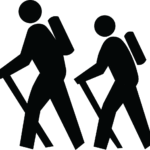 When I originally pitched the idea of visiting Peru, it was, admittedly, a 1-demensional concept. My plan: 14 days hiking various portions of the Inca Trail, culminating in the exploration of Manchu Picchu. Period.
When I originally pitched the idea of visiting Peru, it was, admittedly, a 1-demensional concept. My plan: 14 days hiking various portions of the Inca Trail, culminating in the exploration of Manchu Picchu. Period.
But as is often the case, the moment you state your intent out loud to the universe, it begins to change.
This time it was not the universe that changed my plans, it was actually my husband’s fault. What he said was, “I’m sure there is more to Peru than just the Inca trail.”
I was initially miffed at his insensitivity. However, his simple statement actually snapped me out of my tunnel vision. I was suddenly free to explore a world of possibilities.
What followed was a 9-month quest to learn everything I could about Peru through books, magazine articles, YouTube, and Google searches.
I purchased National Geographic and Smithsonian produced DVDs, and attended seminars and museum exhibits by the same. I also took a crash course in Spanish with the help of Rosetta Stone in hopes of reactivating long-dormant brain cells.
Bingham and Adams
At some point during those 9 months I happened across 2 books, “Lost City of the Incas” by the man himself, Hiram Bingham, and the delightful book, “Turn Right at Machu Picchu,” by Mark Adams.
Bingham’s book was published in 1948 when the author/explorer was in his early 70s. This being 37 years after he, with support from National Geographic and Yale University broadcast the existence of Machu Picchu to the world.
If you choose to read both books, make sure to read Bingham’s first.
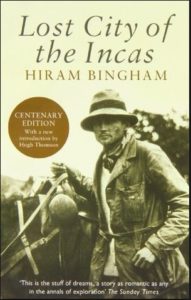
Adams’ humorous, yet insightful book finds him (with the assistance of his guide John Leivers, a Peruvian mule driver—or two–and a cook) retracing Bingham’s steps across Peru. This while also exploring the myth vs. the legend of the man and his ‘discovery.’
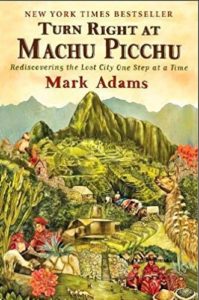
Adam artfully interweaves more recent research, which among other interesting tidbits, suggests Bingham was lackadaisical about his ‘discovery’ of Machu Picchu. He also explores the accusations that Bingham illegally smuggled artifacts out of Peru.
Great Inca Road Exhibit (NMAI)
If you live anywhere near Washington, DC, and you are considering a trip to Peru, The Great Inka Road: Engineering an Empire exhibit at the National Museum of the American Indian (NMAI) is a MUST.
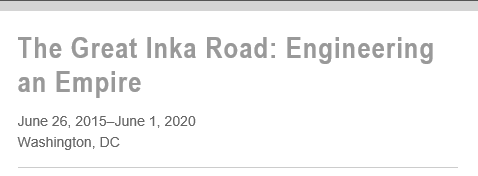
I sought it out early on, and then again just before departing for Peru. To paraphrase the NMAI, the exhibit explores how the Inka Road had its foundations in earlier Andean cultures, and the technologies that made building the road possible. It also explores the cosmology and political organization of the Inca’s, and the legacy of the Inca Empire.
Through the exhibition you will learn that the Inca were only one of many documented Peruvian civilizations (dating back to before 3,000 BCE).
In my humble opinion, the Inca seemed to achieve so much so fast because they were gifted in recognizing, and building upon the best parts of contemporary, and preceding cultures.
However, there is no denying the enormous evidence that the Inca were incredible engineers, planners and managers in their own right.
Why is it then, that almost no one outside of South America is aware of the other cultures? Again, in my humble opinion, one word: publicity.
The Inca happened to be the ruling culture at the time the Spanish invaded. For that reason their cities, and culture were heavily documented by priests, historians and soldiers.
Prior to the Spanish, well, to put it simply– no one was taking notes.
Then fast-forward to the 20th century and Bingham’s “discovery” of Manchu Picchu. Between Bingham and National Geographic the Incas were once again thrust onto center stage.
Now back to the 21st century.
Large Tour vs Small Tour Experience
My take-away from all the reading and research was that a knowledgeable guide and interpreter would greatly enhance our experience. However, hiring a private guide for 3 weeks was (financially) out of the question.
We tried a large tour group experience (once). The tour operation was impeccable, and the life experience was incredible, but the large group wore on us. Because it was such a large group, it had to have highly structured schedules, and could not allow for flexibility of interests.
Also—and this is probably the crux of it—we are quite comfortable with travelling alone, or at most, as a couple. Being in the presence of 40+ other souls for 12 hours per day—EVERY DAY—EVERY MEAL–is not our idea of a relaxing or good time. (But I digress.)
G-Adventures to the Rescue

Eventually I found G-Adventures. They not only offer trips by country, but also by itinerary and activity and/or comfort level within each of those countries. For that reason it took a bit of patience and digging to zero in on the perfect combination of trip itinerary and comfort level vs budget. But persistence paid off.
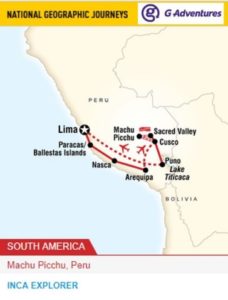
The trip I settled on is a joint offering between G-Adventures and National Geographic called Inca Explorer. It had everything. Lima, visits to off-shore islands in the highest navigable lake in the world, the beauty and power of the Sacred Valley, Cusco, Arequipa, and the awe-inspiring Manchu Picchu. Oh, and how could I forget the mystical Nazca lines?
Tips for Happy & Healthy Peru Trek
But before you book the trip, and hop on a plane headed south, let me mention a few items you should consider to ensure you have the best trek possible. That would be vaccinations, high altitudes, earthquakes, rough terrain, and your personal level of health.
On second thought, this is a good place to stop. I’ll save those topics (and the importance of packing light) for the next entry. This is A Curious Trekker signing off.
[If you haven’t already, check out my TRAVEL TIPS and learn a bit more ABOUT MY TRAVEL BLOG and MY PHOTOGRAPHY by clicking HERE.]
